Craving a simple and genuine breakfast treat?
Semi-whole wheat croissants without butter, milk, and eggs: an easy and quick recipe for homemade croissants.
Light croissants ready in less than an hour!
– without butter for hyperglycemia concerns;
– without milk and eggs for personal taste.
Perfect for those following a vegan diet!
Naturally, the texture is different from the fragrant and soft croissants you find at a cafe, but they are sweet and low-calorie.
The inside is full yet flaky, and the texture is biscuity and crumbly.
I recommend making these types of doughs in small batches and consuming them within one or two days to enjoy their best characteristics as they tend to lose their fragrance due to the absence of certain ingredients.
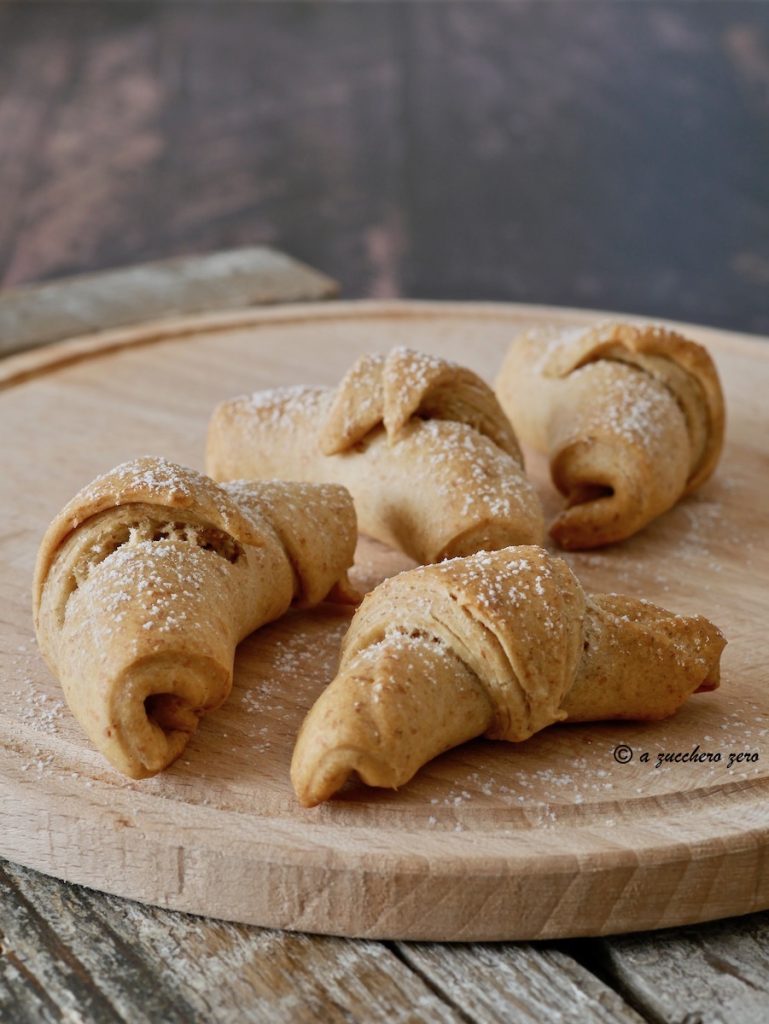
- Difficulty: Easy
- Cost: Economical
- Preparation time: 30 Minutes
- Portions: 8 small croissants or 4 large croissants
- Cooking methods: Electric oven
- Cuisine: Italian
Ingredients
- 1/4 cup water
- 2 3/4 tbsp sunflower seed oil
- 1 tsp coconut sugar (or the sweetener you usually use)
- 3/4 cup spelt flour
- 1/3 cup whole spelt flour
- 1 pinch vanillin
- 1/4 tsp baking powder
- as needed sunflower seed oil
- as needed water
- 1 pinch powdered sugar
- 1 pinch sweetener (erythritol powder – zero calories)
- fruit-only sugar jam (a thin layer)
- sugar-free hazelnut cream (a thin layer)
Suggested Tools
- 1 Glass graduated
- 1 Bowl
- 1 Spatula silicone
- Work surface
- 1 Rolling Pin
- 1 Brush silicone
Preparation
Pour into a graduated glass:
– 60 ml water – or milk or plant-based milk;
– 40 ml sunflower seed oil;
– 5 g sifted coconut sugar – also add the part that doesn’t pass through the sieve – or the sweetener you usually use;
and quickly emulsify the two liquids, dispersing the sugar.Pour the following sifted ingredients into a bowl – also add the part that doesn’t pass through the sieve:
– 100 g spelt flour;
– 50 g whole spelt flour;
– 1 pinch of vanillin;
– 1 g baking powder for sweets;
and mix with a silicone spatula.Pour the liquids into the bowl with the dry ingredients, a little at a time, and knead with your hands until you get an elastic dough.
Transfer the dough to a work surface and continue kneading for a few minutes.
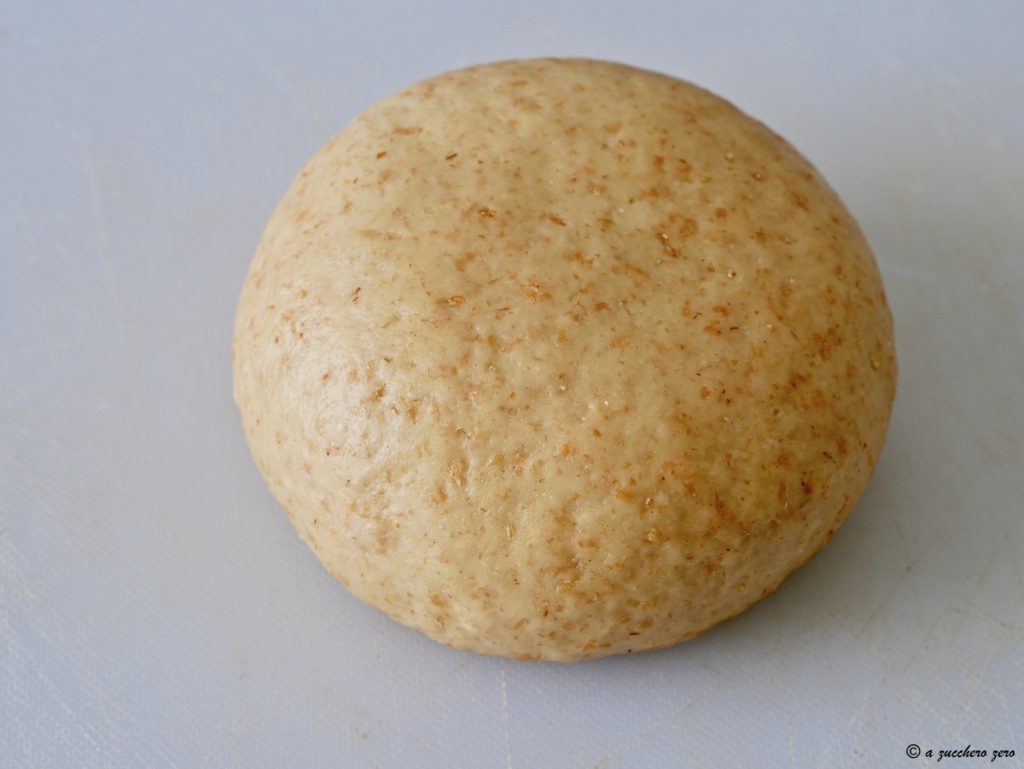
Divide the dough into 4 round-shaped pieces.
Roll out the first piece with a rolling pin until it becomes a thin, round disk.
Place the first disk on parchment paper and brush it with a little oil.
Overlap the second disk, brush, and continue the same way for the third.
The fourth disk should not be brushed.Gently roll out the stack of disks with a rolling pin using 4 light passes:
– from bottom to top;
– from top to bottom;
– from left to right;
– from right to left.The laminated dough disk is ready to be divided into:
– 8 wedges for small croissants;
– 4 wedges for large croissants.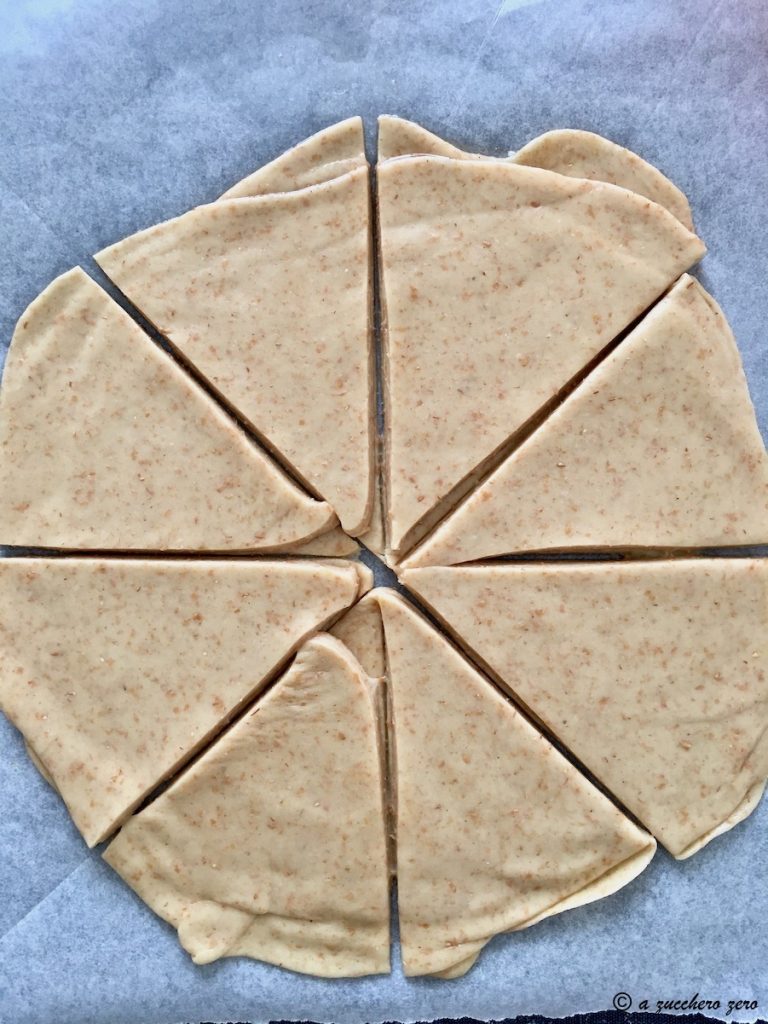
Roll each triangle from the base to the tip, giving it the classic crescent shape.
Slightly fold the tips inward.
Brush the surface with water before baking.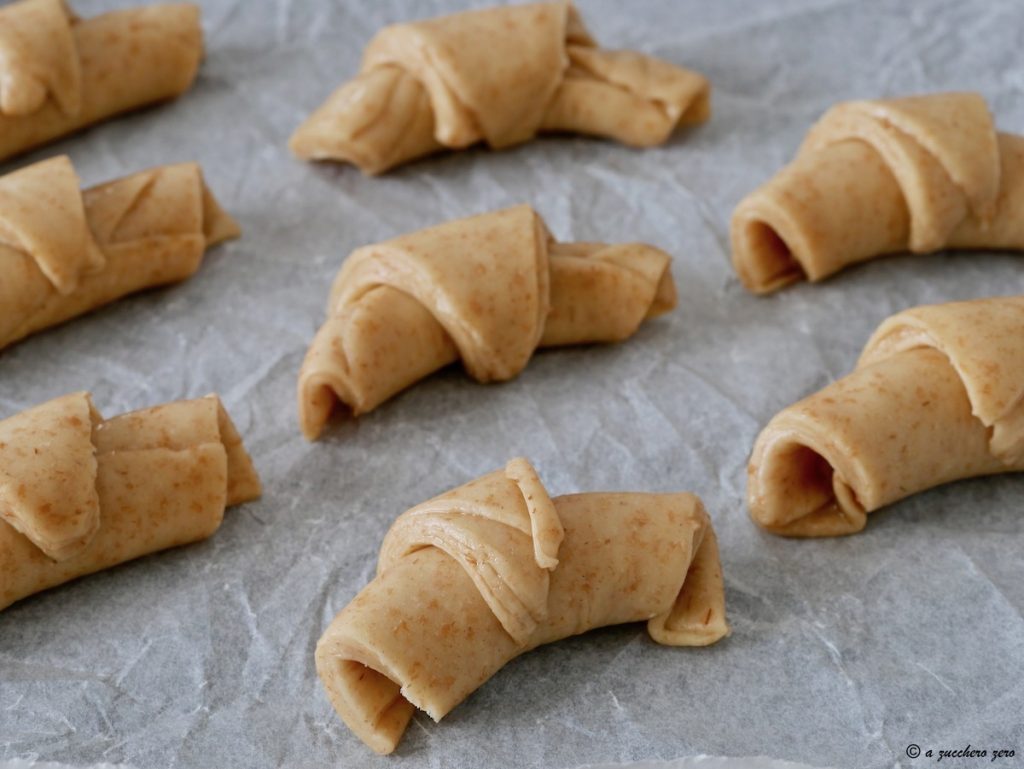
Preheat the oven.
Bake in a fan oven at 350°F for 25-30 minutes, until evenly golden.
Temperatures and times may vary from oven to oven and based on the size of the croissants.Your semi-whole wheat croissants without butter, milk, and eggs are ready.
Enjoy your meal!
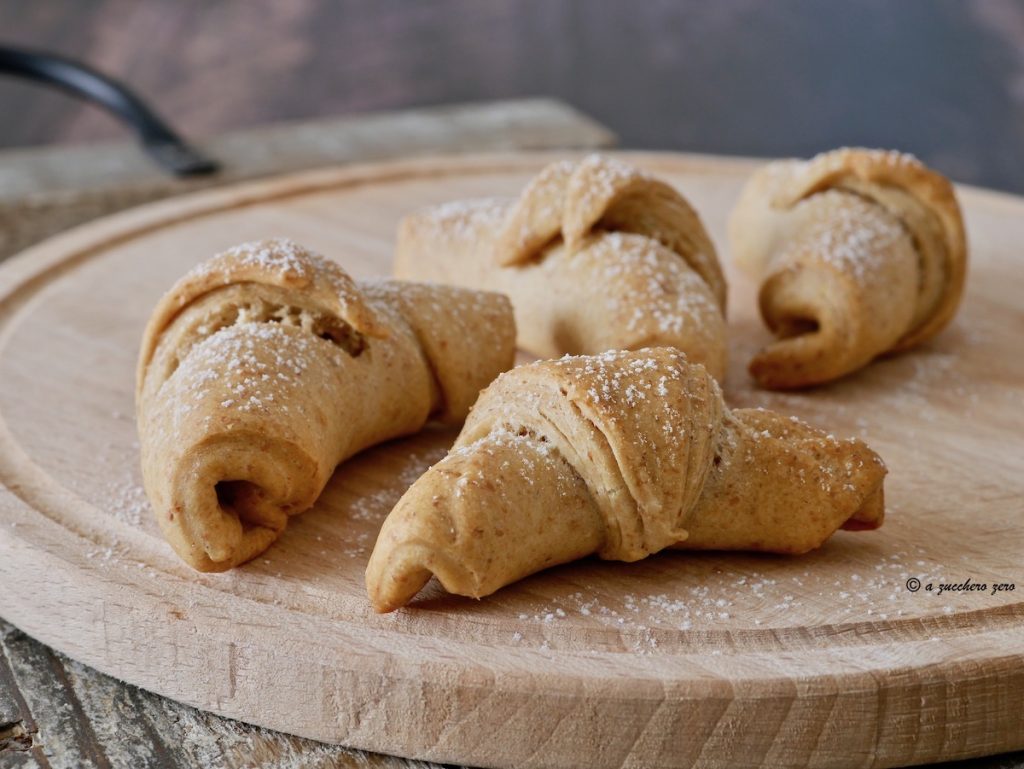
Naturally, the texture is different from the fragrant and soft croissants you find at a cafe, but they are sweet and low-calorie.
The inside is full yet flaky, and the texture is biscuity and crumbly.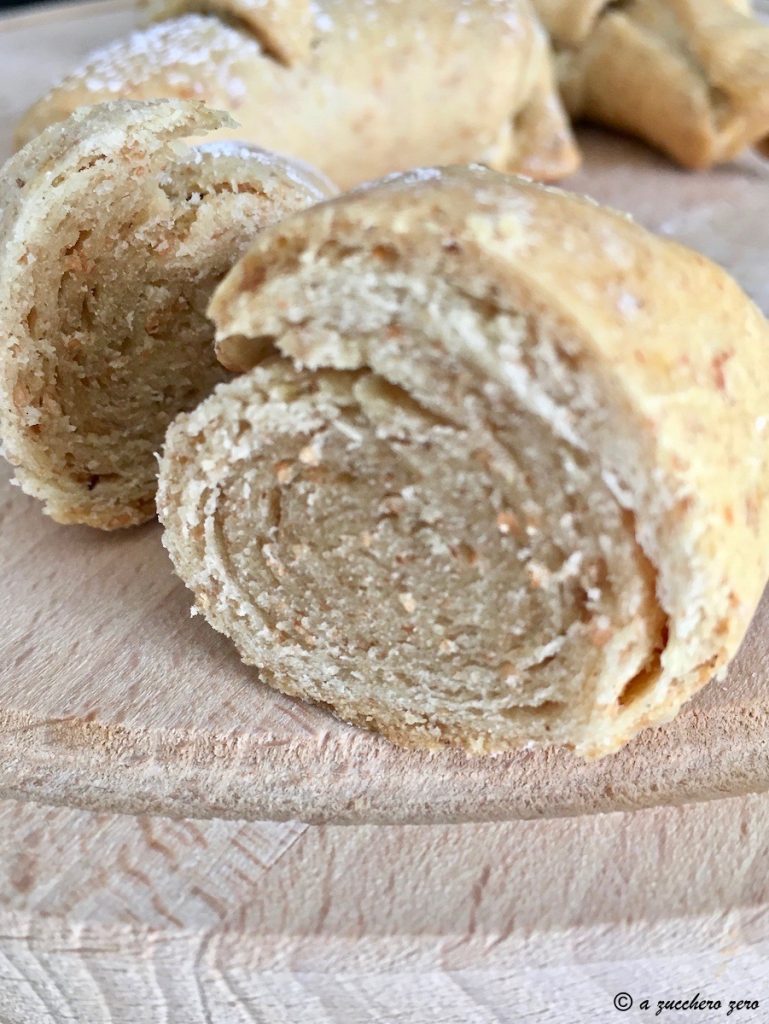
If you prefer them a bit sweeter, sprinkle with a pinch of powdered sugar or erythritol powder – zero calories.
Eat them plain or cut them in half and fill with a thin layer of fruit-only sugar jam or sugar-free hazelnut cream.
Storage, Tips, and Variations
I recommend making these types of doughs in small batches and consuming them within one or two days to enjoy their best characteristics as they tend to lose their fragrance due to the absence of certain ingredients.
Store the croissants in a tin or glass container with an airtight seal.
The croissants will keep for 1-2 days.
We allow ourselves to have them occasionally for breakfast as a substitute for whole wheat toast or whole semolina bread.
As Professor Enzo Bonora generally suggests
It’s important, especially in the presence of diabetes, to build an experience about the impact of this and all other foods on blood glucose. This means measuring before and two hours after eating it. Preferably more than once to have more reliable information. If the blood glucose increase is contained [less than 50 mg], you can put a “green label” on that type of food. Otherwise, it’s better to avoid it.
FAQ (Questions and Answers)
Further Reading
– Whole semolina and flours glycemic index type 2 diabetes.
– Sugar and sweeteners type 2 diabetes.
– Chocolate and glycemic index, which to choose?Can I substitute the flours?
Keep in mind that:
– these are water-based doughs;
– the absence of sugar affects their structure.
Therefore, my advice is to avoid changing the ingredients.
Alternatively:
– Whole semolina and flours glycemic index type 2 diabetes.Why without butter, milk, and eggs?
– without butter for hyperglycemia concerns;
– without milk and eggs for personal taste.
* if you prefer, you can replace water with milk or plant-based milk.

